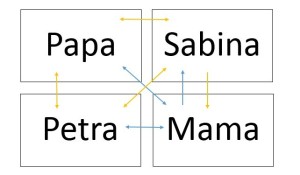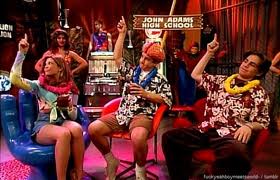My fourth grade daughter reports that of each school day, she only enjoys 40 minutes. And surprisingly, it’s not lunch and recess.
For less than an hour, she and a handful of other “advanced” students leave the regular classroom and spend time in “enrichment” class. There, Evelyn and her cohort read (more) challenging texts, debate how to solve difficult word problems, and craft creative responses to writing prompts.
“Something I really like is when we break into groups and each group has a set of algebra problems to do,” says Evelyn. “I feel like I learn better that way because I have something that I can share with the other people, and seeing what other people did helps me too.”
As far as enrichment goes, Evelyn’s teacher requires nothing remarkably collaborative, challenging, or interdisciplinary. Yet compared to how learning happens in my daughter’s regular classroom, the approaches taken by her enrichment teacher look revolutionary.
When she goes back to class after enrichment, Evelyn must then make up the work she missed in class; she often brings home a stack of worksheets and worry about whether she will earn an NP (Nearing Proficiency), MP (Meeting Proficiency), or EP (Exceeding Proficiency) on her next standardized test. (How someone can *exceed* proficiency is beyond me, but that’s quibbling over semantics.)
In other words, the learning she and her friends do in enrichment isn’t seen as replacing or even extending the regular curriculum. She still must complete every worksheet in order to ensure solid results on the standardized test that Delaware requires she take three times a year, every year.
When I talked with my daughter about some of the classroom projects Cathy Davidson writes about in her book, Now You See It: How Technology and Brain Science Will Transform Schools and Business for the 21st Century, she expressed admiration and a tinge of jealousy. The process-based methods used by innovative teachers like those at Voyager Academy and Quest 2 Learn were both alien and appealing to her.
Mostly what she longs for is to learn in interesting ways. Nearly every subject–from science to social studies, language arts to math–has the potential to interest her and her classmates, but the perpetual testing cycle and limitations of time and focus discourage fun, curiosity, and questions.
The elementary-aged kids I talk to know that the system is broken; they know that standardized testing, at least in its current form, is a chain hanging around their teachers’ (and by proxy, their educations’) necks. But they’re trapped.
“Standardized tests just show what you wrote. They don’t show what you actually know,” explains Evelyn. “Something like a project can show how much a student cares about their work.”
Evelyn, limited by her formal school experiences as well as by her youth, would probably admire Davidson’s idea of an “exciting end-of-grade test” (130). Davidson proposes an end of year “synthesis” that students would create that would use what they had learned that year. The project would show “each child what he or she could do in the world,” and these ideas would be on display at an “idea sale” (130).
In my searching online for a video intersecting with Davidson’s theoretical concepts and my hopes for my children, I found a video made by a class of 7th graders in Joanna Sanders Bobiash’s Grade 7 class at École Wilfrid Walker School. The video, which won the 2009 “Best in Class” Best Buy Contest, grew out of a collaborative text written by the students based on their goals for the future and the impact of technology on their lives.
See the video here (I’m having trouble getting it to embed from tubechop).
Now, there are many other more polished videos available on Youtube, even those ostensibly made by middle schoolers. This one did not stand out to me because of its professionalism; the video footage and editing is fine and the audio quality is okay.
What moved me deeply was getting to hear the words and voices of young adolescents speaking their goals and dreams. Not by themselves in private. Not to a friend or family member. But as a team, to the world (and in two languages, no less!).
One young woman says, “I want to share my work with the world and learn from their feedback.”
That simultaneous confidence in reaching out and acknowledgement of what one has yet to learn, it seems to me, are at the heart of Davidson’s manifesto: “Confidence in your ability to learn is confidence in your ability to unlearn,” writes Davidson, “to switch assumptions or methods or partnerships in order to do better” (86).
Schools that encourage and reward that simultaneous confidence (learning) and awareness of personal shortcomings (unlearning): that’s what I want for my daughters and my son.
But when another thick packet of worksheets and workbook pages land on the kitchen counter, it’s hard to feel hope that a place like Ms. Bobiash’s 7th grade class and Q2L and Voyager Academy are more than rare mirages in an educational morass.





